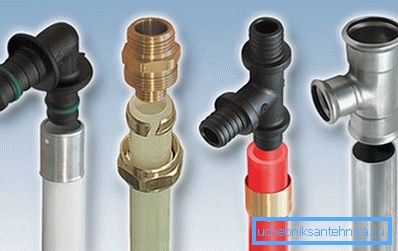Pipes for water, which material is best suited for them
Do you make a planned repair or build from scratch - the purchase of pipes for water supply is waiting for you. And here comes a lot of questions about their diameter, material, cost and footage. The store will offer you metal and polyurethane pipes for water, as well as newfangled additions. So as not to get confused, it is necessary to decide on all of this in advance.

Popular pipe types
Any buyer is concerned about the quality of the material at a real price.
That's what we offer in the average store or on the market.
- Steel pipes.
- Copper Products.
- Plastic materials.
- Metal version.
They are distinguished not only by price and purpose, but also by technical characteristics.
Product Quality Overview
Let's take a look at the most frequent professional advice given to ordinary citizens.
- Steel analogues. They are not checked by one generation, are still quite popular. Especially beneficial in cases where the planned heating of water in the pipes. For hot water or heating system to take this material is profitable.
Note! It tolerates steel high pressure and temperature drops. The disadvantages include heavy weight, rather complicated installation and a tendency to the formation of rust and condensate.

- A copper conduit will last longer than other materials.. But it will cost such pleasure very expensive. In addition, the installation of elite communications does not tolerate amateurs. Good experts will cost a pretty penny.
- Polyvinyl chloride (PVC) pipes are deservedly popular. The material is inexpensive, practical, suitable for both cold and hot water. In addition, PVC pipes for water do not require time-consuming welding or threading. Connect butt or socket joint. They are easy to get special fittings for connecting pipes.

- Polyethylene and polypropylene product is available and will not ruin the buyer. The pipes are so flexible that they calmly withstand the pressure of the water frozen inside and do not burst. Summer residents or homeowners who prefer to work with their own hands will appreciate the pipes. Rigid options are connected by fittings, but usually the installation is done by soldering.
Note! Is low pressure polyethylene able to withstand a temperature drop of 0? up to +40? . Much higher characteristics of polyethylene crosslinked. It is used for hot water as well as heating.

- Metal plastics can be considered as leaders, due to the mass of advantages. The pipe is a three-layer structure. Metal frame (solid, spiral or perforated) on both sides provided with plastic protective layers.
The enclosed instruction promises uninterrupted service of the product for 25/50 years and high-quality work at temperatures up to +95 ?. Connect the elements with fittings, which simplifies installation. For heating systems, this option is not the most profitable, as from a high pressure and temperature pipes can leak at the joints.
But for ordinary water supply (cold and hot) the material is almost perfect.
Note! Often the owners are at a loss - why does the water in the pipes rustle, because the system is mounted correctly? This problem is familiar to those who have metal pipes. They have low sound absorption. Those who appreciate silence, it is recommended to use plastic water pipes.
Supplements for water pipes
It is considered to be that self-assembly and installation of a water supply system is extremely complex and requires exclusively professional intervention.
In fact, this is not the case, because modern materials and additions to them are designed for a wide range of consumers.
- Are pipes used more often for domestic water supplies? and? inches, which corresponds to 16 mm and 20 mm.
- For certain pipes, appropriate fittings should be purchased (labeled 16, 20, etc.).
- Always indicate the inside diameter of the pipe in inches.
- Special glue will strengthen the strength of fasteners. Then the probability of leakage at the joints is reduced to a minimum.
- To control the filling of systems, an effective sensor is the presence of water in the pipe, eliminating the useless operation of the pump (dry, idle). It consists of a conductometric cell with stainless pin electrodes, a threaded nipple, an aluminum terminal box with a conversion board. The output in the form of a dry contact is 100 V, 150 mA.
Which pipes are better
After the advice of friends and acquaintances, there is usually even more confusion about the material from which to choose a water supply system.
Metal

- The steel pipe will be durable, will last at least 25 years with good care.
- It maintains the maximum temperature and pressure for water.
- Proper installation will relieve from leaks.
- It has considerable weight and poor sound insulation.
- Installation is time consuming, only welding or cutting pipe threads.
- The tendency to rust spoils the taste of water and its quality.
- Condensate on pipes with cold water contributes to dampness and mold.
Plastic

- Good elasticity will not allow ruptures even when the liquid is freezing.
- Water will not make noise due to good sound insulation.
- Material is not subject to corrosion at all.
- Installation and repair extremely easy.
- Unlike steel, plastic is less durable, pipes are softer (they do not withstand very high temperatures and high and prolonged pressure).
Note! The stores offer a plastic water filter tube that can clean even the dirtiest water to the level of drinking water. 25 cm long, equipped with a cleaner of activated carbon and PuroTech Disinfecting Resin material, it will help out at the cottage and on the road.
Conclusion
Being armed, what makes the pipes for water, you will not get lost when buying. Use a load-oriented material, and save yourself from problems and unnecessary costs. In our video in this article you will find even more useful information.